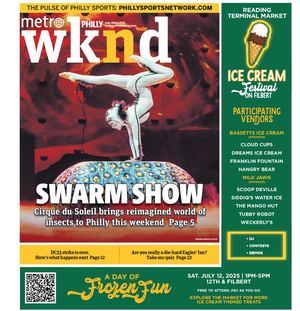 Cardboard Computer created a video game honoring the non-existent artist Lula Chamberlain.
Cardboard Computer created a video game honoring the non-existent artist Lula Chamberlain.
Artists are rarely fully satisfied with the end result of their efforts. The gulf between imagination and realization is a complaint echoed across genres and styles. But that gulf may be widest for new media artists, whose vision often outpaces the technology available to them.
That’s the idea behind “Limits and Demonstrations,” a new exhibition at Little Berlin that presents the work of fictional “pioneering new media installation artist” Lula Chamberlain in both virtual and real-world versions. “As a curator and as an artist, I’ve noticed that there’s often a split between what an artist thinks and says compared to what the artwork actually looks like,” says curator Lee Tusman. “It’s like seeing something in a movie and then seeing it in real life, or hearing someone on the phone and then meeting them in person. That disconnect is a powerful experience that can’t be replicated in other ways.”
That disconnect is complicated by the made-up story of Chamberlain herself, who is presented in the context of the exhibition as a long-forgotten visionary — but is actually a character in the eccentric video game “Kentucky Route Zero,” created by Chicago-based game development company Cardboard Computer. They crafted “Limits and Demonstrations,” which will be presented in video game form within a cinema space at Little Berlin, as a virtual museum of the late, lamented and fictional artist’s creations.
“I’ve been investigating the intersection of the arts and game design,” Tusman says, “and Cardboard Computer has been pushing the limits in many different ways. In ‘Limits and Demonstrations’ you walk into this virtual museum and learn more about Lula Chamberlain and her work. I was fascinated by the story of this artist that was largely unknown and forgotten but who was doing groundbreaking work.”
Nothing in what Tusman or game designers Jake Elliott and Tamas Kemenczy say about Chamberlain – who was ostensibly forgotten by art history because of a move to Mexico decades before her death – hints at her non-existence in physical reality. The idea of a virtual artist adds an interesting wrinkle to conceptual art, which often exists as a concept without a form; here it’s the artist that is imaginary, the work real.
“The interesting thing for me is comparing the works in their virtual and idealized form to the works in their physical manifestations,” Tusman says of the show. “That’s still an issue that artists deal with today – ‘I have a vision in my mind, can I make this happen the way I see it?’ And then the work takes on its own life.”
“Limits and Demonstrations”
Oct. 4-26
Little Berlin
Viking Mill, 2430 Coral St.
Free
www.littleberlin.org



























